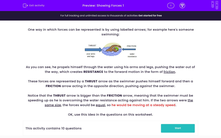One way in which forces can be represented is by using labelled arrows.
For example, here's someone swimming:

As you can see, he propels himself through the water using his arms and legs, pushing the water out of the way, which creates resistance to the forward motion in the form of friction.
These forces are represented by a thrust arrow as the swimmer pushes himself forward and then a friction arrow acting in the opposite direction, pushing against the swimmer.
An important rule of force diagrams is that a bigger arrow represents a bigger force. This allows us to easily see whether forces are balanced or unbalanced. If all the forces on an object are balanced, this is called equilibrium, and it means the object is either stationary (not moving) or moving at a constant speed.
Notice that the thrust arrow is bigger than the friction arrow, meaning that the swimmer must be speeding up as he is overcoming the water resistance acting against him. If the two arrows were the same size, the forces would be equal, so he would be moving at a steady speed.
Use these ideas to help you answer the questions in this activity.
.jpg)








